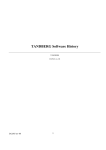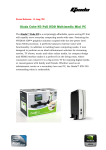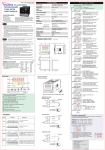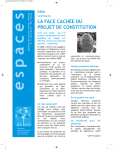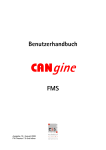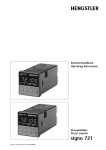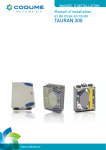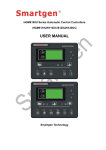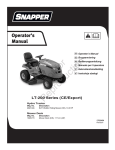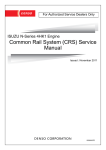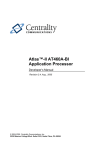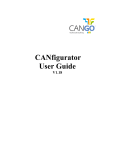Download CANGO FMS Interface Serial User Guide
Transcript
CANGO FMS Interface Serial User Guide (rev24072014) CANGO Telematic Interface - Serial User Guide (24/07/2014) CANGO is property of GOTRACK TECHNOLOGY s.r.l. The information given in this document was compiled and carefully checked. Nevertheless GOTRACK TECHNOLOGY s.r.l. assumes no liability for any mistakes. GOTRACK TECHNOLOGY s.r.l. also assumes no liability for any damage resulting from use of this manual or products described herein. GOTRACK TECHNOLOGY s.r.l. reserves the right to make changes on information given in this document and on features of the products described herein without prior notification. Publication and reproduction of this document or parts of it will only be possible after a written agreement with GOTRACK TECHNOLOGY s.r.l., Romania, Jud. Calarasi, Oltenita 915400, 25 Pescarilor Str., M5 Bl., 4th floor. Related Documents SAE J1939 / 71 Vehicle Application Layer Clarification of FMS data SAE J1708 SAE J1587 Notation of special characters [CR] Enter key or character code carriage return (0x0D) – if you will use Hercules you must type: $0D [LF] character code linefeed (0x0A) [NULL] means no character 1 CANGO Telematic Interface - Serial User Guide (24/07/2014) 1 Connection After the hardware connection you can connect to the interface with terminal software (i.e.: Terminal or Hercules). The default configuration of the FMS interface is: 115200 bps; 8 Data bits; 1 Stop bit; No handshake (flow control). Below is an example about how to connect to the interface with Terminal and the steps you will need to do: 1. First you need to set: 2. 3. 4. “Data bits” to 8; “Parity” to “none”; “Stop bits” to 1; “Handshaking” to “none” or “RTS/CTS”; Set the “Baud rate”; From factory by default is set to 115200 bps; Set the “COM Port”; In this example the port is COM1, your port may differ; Press “Connect”; Fig 1 - Terminal, before connection to the interface for default configuration. 2 CANGO Telematic Interface - Serial User Guide (24/07/2014) After the configuration of the connection parameters and connecting to the COM port, the device should sent data in Readable Table Frame format (factory settings). Below is an example: Fig 2 - Terminal, connected to the interface, set on readable mode. 3 CANGO Telematic Interface - Serial User Guide (24/07/2014) 2 The Output Protocol (FMS Mode) 2.1 Overview In normal operating mode the interface reads the vehicle data and sends the data through the RS-232 serial cables and CANbus output. Both outputs, RS232 and CANbus, are active. The serial output has three main types of frames. Readable table frame easy to read by human operator, Spreadsheet frame and five “T” frames, for instant values, for total values, for tachograph values and for the MILs. The ASCII output for the serial link is built up and sent either in a cycle period given by the #sint command. The serial output is given in the format defined by the #sint parameters and #mask parameter. For the complete Serial guide please see chapter 3. The data is also being sent like standard 2.0 J1939/FMS protocol on the CAN2 bus port. Spreadsheet Frame One line holds all parameter values separated by the field separator character (comma by default) character. Readable Table Frame Readable Table frame with variable names and physical units. “T” Frames 5 standard frames: T1 – Instant values. T2 – Totals and calculated values. T3 – Threshold compare values. T5 – Tachograph values. T6 – Diagnostic Trouble Codes. Useful for testing on site. Configurable prefix and suffix. Filter Mask on each FMS Frame. Configurable send time between 2 messages. Requests: #T1[CR] – Requests the T1 message. #T2[CR] – Requests the T2 message. #T3[CR] – Requests the T3 message. #T5[CR] – Requests the T5 message. #T6[CR] – Requests the T6 message. Set messages: $T2 – Sets the totals and calculated values. $T3 – Sets the threshold compare values Table 1 - General description of the frames. 4 CANGO Telematic Interface - Serial User Guide (24/07/2014) 2.2 Spreadsheet frame When spreadsheet frame is enabled, a reduced spreadsheet frame without any variable names and units is selected. All numerical values are separated by the field separator character (comma by default). One line holds all values selected with the mask command. Similar to the readable frame all variables with special meaning or that are not available are marked with the characters 'n', 'e', 'o' or '*'. The line is started by the prefix (#pfx command, default is a blank prefix) and terminated by the suffix (#sfx command, [CR][LF] is default). String: [Prefix][timestamp],[value01],[value02], … ,[valueN][Suffix] FMS Name String Mask [Prefix] [Time stamp], [Engine Speed], EEC1 Bit 0 [Accelerator pedal],[Engine load], EEC2 Bit 1 [TCO speed],[MD],[OS],[DI],[TP],[HI],[EV],[D2A],[D1WS],[D1TS],[D2A],[D2WS],[D2TS], TCO Bit 2 [WBSD],[CC],[BR],[CS],[PTO], CCVS Bit 3 [Service], SERV Bit 4 [Distance], VDHR Bit 5 HOURS Bit 6 [Total fuel consumption], LFC Bit 7 [Axle weight 0],[Axle weight 1],[Axle weight 2] VW Bit 8 [Coolant temperature], ET1 Bit 9 [Fuel level], DD Bit 10 [Vehicle ID], VI Bit 11 AMB Bit 12 DI Bit 13 LFE Bit 14 [PTO engagement], PTODE Bit 15 [Total fuel high resolution] HRLFC Bit 16 [Engine on time], [Ambient Temperature], [Driver 1 ID], [Driver 2 ID], [Fuel rate],[Instant fuel economy], [Suffix] Table 2 – Parameter on the Spreadsheet frame. The prefix and the suffix are configurable. By default the prefix is empty and the suffix is [CR] [LF]. The time between two messages can be configured by the #sint command. 5 CANGO Telematic Interface - Serial User Guide (24/07/2014) Measurements units Engine speed Accelerator Pedal Engine Percent Load WBSD (Wheel Based Speed) Service Distance Engine ON Time Total Fuel Consumption Axle weight 0,1,2 Coolant Temp. Tachograph Sign MD OS DI TP HI EV D1A D1WS D1TS D2A D2WS D2TS Value 0 or 1 0 or 1 0 or 1 0 or 1 0 or 1 0 or 1 0 or 1 0 ... 7 0 ...15 0 or 1 0 ... 7 0 ...15 Driver Information Time state Normal 0 15 min. bef. 4 ½ hours 1 4 ½ hours reached 2 15 min. bef. 9 hours 3 9 hours reached 4 15 min. bef. 16 hours 5 16 hours reached 6 Error 14 Not available 15 Rpm Fuel Level % Vehicle ID % max Ambient Temperature Km/h Driver ID Km Fuel Rate Km Instant Fuel Economy Hours PTO Engagement L Total Fuel High Resolution Kg TCO Speed °C Tachograph (see table 4) Table 3 – Measurements units. L ASCI °C ASCI L/h Km/L 1 or 0 L Km/h Meaning Motion detected (1: yes, 0: no) Over speed detected (1: yes, 0: no) Direction (0: forward, 1: reverse) Tachograph performance (1: analyze, 0: normal) Handling information (1: yes, 0: no) Tachograph event (1: yes, 0: no) Driver 1 information (1: present, 0: absent) Working state driver 1 (see table 5) Time state driver 1 (see table 5) Driver 2 information (1: present, 0: absent) Working state driver 2 (see table 5) Time state driver 2 (see table 5) Table 4 - Tachograph values description. Working state Rest 0 Available 1 Work 2 Drive 3 Error 6 Not available 7 Table 5 - Driver information. 6 CANGO Telematic Interface - Serial User Guide (24/07/2014) 2.3 Readable table frame When Readable Table frame is enabled, the output is set to readable 'screen format' with variable names and physical units. Identifier String 0-00:00:29.000 EngSpeed 0.000 rpm Accel 0.0 % Load 0.0 % TCO 0.0 km/h MD 0 OS 0 DI 0 TP 0 HI 0 EV 0 D1:0/0/0 D2:0/0/0 Speed 0.00 km/h CC:0 BR:0 CS:0 PTO:0 Service 0 km Distance 0.000 km EngHours 0.00 h FuelC 0.0 L Weight 0 kg (n) 0 kg (n) 0 kg (n) EngTemp 0 degr FuelLev 0.0 % VehID * Ambient temp.: n/a degr Driver ID:n/a,n/a Fuel Economy: Rate: n/a L/h, Inst. economy: n/a km/L PTOEN: 0 HRLFC: 0.000 L FMS: 2.0 Diag:0 Req:0 2.4 “T” Frames When “T” Frames are enabled the output data is organized in serial frames. The “T” frames are 5 standard messages: - Instant (actual) values (T1 frame) Total and calculated values (T2 frame) Threshold compare values (T3 frame) Tachograph values (T5 frame) Diagnostic Trouble Codes (T6 frame) 2.5 Frames timing Each serial frame can be configured to be broadcasted at a period of time with a delay (offset) from startup. Below, you can see an example of timing diagram. X,Y,Z are generic frames and can be any of the described above. Fig 3 – Example of timing diagram for serial frames 7 CANGO Telematic Interface - Serial User Guide (24/07/2014) 2.5.1 Messages 2.5.1.1 Instant values - T1 This frame contains the instant values and it is sent at a time interval set by the #sint command or on request. To disable the timed broadcast set the interval to 0 seconds. String [Prefix1]T1, [Speed], Measurements units Data type Km/h Float, 0 to 250.996 Km/h, Resolution 1/256 Km/h [Engine], Rpm Float, 0 to 8031.875 Rpm, Resolution 0.125 Rpm [Fuel consumption], [Fuel level primary tank], [Axel weight 1], l/h % Kg Float, 0 to 3212.75 l/h, Resolution 0.05 l/h Float, 0 to 100 %, Resolution 0.4 % Float, 0 to 32127.5 Kg, Resolution 0.5 Kg [Axel weight 2], Kg Float, 0 to 32127.5 Kg, Resolution 0.5 Kg [Axel weight 3], [Axel weight 4], [Turbo pressure], [Coolant temperature], [Accelerator pedal], [Torque], [Firmware version], [Battery voltage], [Coolant level], [Oil temperature], [Oil level], [Throttle position], [Air inlet pressure], [Fuel level secondary tank], Kg Kg kPa °C % %max Float, 0 to 32127.5 Kg, Resolution 0.5 Kg Float, 0 to 32127.5 Kg, Resolution 0.5 Kg Float, 0 to 8031.875 kPa, Resolution 0.125 kPa Integer, -40 to 210 °C, Resolution 1 °C Float, 0 to 100 %, Resolution 0.4 % Integer, 0 to 250 %, Resolution 1 % Char Float, 0 to 3212.75 Volts, Resolution 0.05 Volts Float, 0 to 100 %, Resolution 0.4 % Float, -273 to 1734.96875 °C, Resolution 1/32 °C Float, 0 to 100 %, Resolution 0.4 % Float, 0 to 100 %, Resolution 0.4 % Integer, 0 to 500 kPa, Resolution 2 kPa Float, 0 to 100 %, Resolution 0.4 % Integer, 0 is Neutral; 1 to 125 is forward; -125 to -1 is reverse; 251 is parked. Char, 0 - Not buckled; 1 - Ok; seat belt is buckled; 2 - Error or switch state cannot be determined; 3 - Not available. Float, 0 to 1000 kPa, Resolution 4 kPa Float, 0 to 2000 kPa, Resolution 8 kPa Volts % °C % % kPa % [Transmission current gear], [Seat belt], kPa [Engine oil pressure], kPa [Wet tank air pressure] 2 [Suffix ] Table 6 – Parameter of the T1 frame, with the respective units and data type. 1 2 Prefix is configurable. By default the prefix is empty. Suffix is configurable. By default the suffix is [CR][LF]. 8 CANGO Telematic Interface - Serial User Guide (24/07/2014) 2.5.1.2 Totals and calculated values – T2 This frame contains the total and calculated values and it is sent at a time interval set by the #sint command or on request. To disable the timed broadcast set the interval to 0 seconds. Data type Measurements units String [Prefix3]T2, Float, 0 to 21055406 km, Resolution 0.005 km Km [Mileage], Float, 0 to 2105540607.5 L, Resolution 0.5 L Liter [Total fuel], Float, 0 to 2105540607.5 L, Resolution 0.5 L Liter [Fuel used at cruise], Float, 0 to 2105540607.5 L, Resolution 0.5 L Liter [Fuel used at drive], Integer, 0 to 65535 times, Resolution 1 time Times [Idle longer than 5 minutes], Integer, 0 to 65535 times, Resolution 1 time Times [Idle longer than 10 minutes], Integer, 0 to 4294967295 s, Resolution 1 s Sec. [Total idle time], Integer, 0 to 4294967295 s, Resolution 1 s Sec. [Total time PTO], Integer, 0 to 4294967295 s, Resolution 1 s Sec. [Time cruise], Integer, 0 to 4294967295 s, Resolution 1 s Sec. [Rpm > threshold RPM 1], Integer, 0 to 4294967295 s, Resolution 1 s Sec. [Rpm > threshold RPM 2], Integer, 0 to 4294967295 s, Resolution 1 s Sec. [Speed > threshold speed 1], Integer, 0 to 4294967295 s, Resolution 1 s Sec. [Speed > threshold speed 2], Integer, 0 to 4294967295 s, Resolution 1 s Sec. [Speed > threshold speed 3], Integer, 0 to 65535 times, Resolution 1 time Times [Brake apps], Integer, 0 to 65535 times, Resolution 1 time Times [Clutch apps], Integer, 0 to 4294967295 s, Resolution 180 s Sec. [Engine on], Integer, 0 to 4294967295 s, Resolution 1 s Sec. [Time torque > 90%], Float, 0 to 3212.75 l/h, Resolution 0.05 l/h L/h [Fuel rate average] 4 [Suffix ] Table 7 - Parameter of the T2 frame, with the respective units. 2.5.1.3 Threshold compare values – T3 This frame contains the threshold compare values and it is sent back by request and also as a result of #T3 set command. String [Prefix5]T3, [Threshold RPM 1], [Threshold RPM 2], [Threshold speed 1], [Threshold speed 2], [Threshold speed 3] [Suffix6] Measurements units Rpm Rpm Km/h Km/h Km/h Data type Float, 0 to 8031.875 Rpm, Resolution 0.125 Rpm Float, 0 to 8031.875 Rpm, Resolution 0.125 Rpm Float, 0 to 250.996 Km/h, Resolution 1/256 Km/h Float, 0 to 250.996 Km/h, Resolution 1/256 Km/h Float, 0 to 250.996 Km/h, Resolution 1/256 Km/h Table 8 - Parameter of the T3 frame, with the respective units 3 Prefix is configurable. By default the prefix is empty. Suffix is configurable. By default the suffix is [CR][LF]. 5 Prefix is configurable. By default the prefix is empty. 6 Suffix is configurable. By default the suffix is [CR][LF]. 4 9 CANGO Telematic Interface - Serial User Guide (24/07/2014) 2.5.1.4 Tachograph values – T5 This frame contains tachograph data and it is sent at a time interval set by the #sint command or on request. To disable the timed broadcast set the interval to 0 sec. String [Prefix7]T5, [Driver 1 work state], [Driver 2 work state], [Driver recognize], [Driver 1 time state], [Card driver 1 present], [Over speed], [Driver 2 time state], [Card driver 2 present], [Tacho event], [Handling info], [Tacho performance], [Direction indicator], [Output shaft speed], [TCO vehicle speed], [Driver ID 1], [Driver ID 2] [Suffix8] Measurement units 0 or 1, 0 or 1 0 or 1 0 or 1 0 or 1 0 or 1 0 or 1 0 or 1 0 or 1 0 or 1 0 or 1 0 or 1 Rpm Km/h Data type / Meaning Working state (see Table 5) Working state (see Table 5) Driver recognition (1: yes, 0: no) Time state (see Table 9) Driver 1 information (1: present, 0: absent) Overspeed detected (1: yes, 0: no) Time state (see Table 10) Driver 2 information (1: present, 0: absent) Tachograph event (1: yes, 0: no) Handling information (1: yes, 0: no) Tachograph performance (1: analyze, 0: normal) Direction (0: forward, 1: reverse) Float, 0 to 8031.875 Rpm, Resolution 0.125 Rpm Float, 0 to 250.996 Km/h, Resolution 1/256 Km/h Char Char Table 11 - Parameter of the T5 frame, with the respective units. 7 8 Prefix is configurable. By default the prefix is empty. Suffix is configurable. By default the suffix is [CR][LF]. 10 CANGO Telematic Interface - Serial User Guide (24/07/2014) 2.5.1.5 Diagnostic Trouble Codes – T6 This frame contains the Diagnostic Trouble Codes and it is sent at a time interval set by the #sint command or on request. To disable the timed broadcast set the interval to 0 sec. In this frame parameters are sent as decimal base system, to understand the meaning is necessary to converter from decimal to binary base system. After having the value of the parameter you can see the tables bellow to extract the meaning. String Bit 7 Bit 6 Bit mapping Bit 4 Bit 3 Bit 5 Bit 2 Bit 1 Bit 0 [Prefix9]T6, [Warning lamps status], Malfunction Lamp Status Red Stop Lamp Status Amber Warning Lamp Status Protect Lamp Status [Seat belt reminder], Reserved Seat Belt Reminder [Handbrake On], Reserved Hand Brake ON Lamp [Battery malfunction], Fault Active Reserved Failure Mode Indicator [Coolant temperature], Fault Active Reserved Failure Mode Indicator [Oil pressure], Fault Active Reserved Failure Mode Indicator [Brake pads wear], [Stop light], [Electronic water fault], Axle Number Brake Stroke Status Reserved Wheel Red Stop Lamp Status Under Research & Development [Particle filter fault], Under Research & Development [Exhaust gas fault], [ABS malfunction], [Oil level fault] Under Research & Development Reserved Fault Active Reserved ABS Fully Operational ABS Warn Lamp Failure Mode Indicator [Suffix10] Table 12 - Parameters of the T6 frame, and respective Bit mapping. 9 10 Prefix is configurable. By default the prefix is empty. Suffix is configurable. By default the suffix is [CR][LF]. 11 CANGO Telematic Interface - Serial User Guide (24/07/2014) Meaning of the data Malfunction Indicator Lamp Status Red Stop Lamp Status Amber Warning Lamp Status Protect Lamp Status ABS Warn Lamp 00 = 01 = 10 = 11 = Off On Error condition Not available Hand Brake ON Lamp Seat Belt Reminder Fault Active Axle Number 0 = Fault not Active 1 = Fault Active 0-1111 = Front to Back 000 = OK 001 = Out of adjustment 010 = Delay brake return 011 = Brake pads worn Brake Stroke Status 100 = Delayed brake application 101 = Reserved 110 = Error 111 = Not available 1 = Left Wheel Wheel 0 = Right Wheel 00 = Not Fully Operational ABS Fully Operational 01 = Fully Operational 10 = Reserved 11 = Not available 00000 = Data valid but above normal operational range (e.g. engine overheating for Coolant Temperature) 00001 = Data valid but below normal operational range (e.g. engine oil pressure too low) 00010 = Data erratic, intermittent, or incorrect 00011 = Voltage above normal or shorted high Failure Mode Indicator 00100 = 00101 = 00110 = 00110 = Voltage below normal or shorted low Current below normal or open circuit Current above normal or grounded circuit Current above normal or grounded circui 01000 = Abnormal frequency, pulse width, or period 01001 = Abnormal update rate 01010 = Abnormal rate of change 01011 = Failure mode not identifiable 01100 = Bad intelligent device or component 01101 = Out of Calibration 01110 = Special Instructions 01111 - 11111 = Reserved for future assignment Table 13 – Meaning of parameters in the T6 frame. 12 CANGO Telematic Interface - Serial User Guide (24/07/2014) 2.5.2 Requests This message is sent to the interface to request one of the frames. This command will make the FMS interface to send only one time the frame requested. Command syntax #T1[CR][LF] #T2[CR][LF] #T3[CR][LF] #T5[CR][LF] #T6[CR][LF] Description This message is a request for instant values. This message is a request for total values. This message is a request for threshold compare values. This message is a request for tachograph data. This message is a request for DTCs status. Table 14 – Commands to request a Frame. 2.5.3 Sets 2.5.3.1 Totals - #T2 This message is sent to the interface to set the T2 frame parameters. This is to set the values to as showed by the vehicle when they are calculated by the FMS interface. Measurements units String #T2, Km [Mileage], Liter [Total fuel], Liter [Fuel used at cruise], Liter [Fuel used at drive], Times [Idle longer than 5 minutes], Times [Idle longer than 10 minutes], Sec. [Total idle time], Sec. [Total time PTO], Sec. [Time cruise], Sec. [Rpm > threshold RPM 1], Sec. [Rpm > threshold RPM 2], Sec. [Speed > threshold speed 1], Sec. [Speed > threshold speed 2], Sec. [Speed > threshold speed 3], Times [Brake apps], Times [Clutch apps], Sec. [Engine on], Sec. [Time torque > 90%], L/h [Fuel rate average] [CR][LF] Table 15 – Command to set the total and calculated values. 13 CANGO Telematic Interface - Serial User Guide (24/07/2014) 2.5.3.2 Threshold compare values - #T3 On the fms interface there is not problem. On the car you can have dtc errors and you might have to disconnect the battery of the car to restart the ecus and solve this problem. this should not affect the car permanently. Measurements units String #T3, Rpm [threshold_rpm_1], Rpm [threshold_rpm_2], Km/h [threshold_speed_1], Km/h [threshold_speed_2], Km/h [threshold_speed_3] [CR][LF] Table 16 - Command to set the threshold compare values. 14 CANGO Telematic Interface - Serial User Guide (24/07/2014) 3 CONFIGURATION MODE 3.1 General Considerations about Configuration Mode In order to configure CANGO Telematic Interface, the user should use the commands described below and border them with #CFG Command at the beginning and #reset Command at the end. Command #CFG[CR][LF] #command_1[CR][LF] #command_2[CR][LF] #command_n[CR][LF] #CFG[CR][LF] #discard[CR][LF] #save[CR][LF] #reset[CR][LF] #FMS[CR][LF] Description Enter Configuration Mode and get current configuration First command Second command n’th command Verify the actual configuration Save or discard your configuration Reset the interface if you saved your configuration or return to FMS mode. Table 17 - Example of commands. 3.2 Commands overview All commands will start with “#” (0x23, hash character, or pound sign) and will end with Carriage Return and Line Feed (0x0D and 0x0A) characters. Syntax #CFG[CR][LF] #FMS[CR][LF] #sbaud___[CR][LF] #cbaud___[CR][LF] #sint___[CR][LF] #soff___[CR][LF] #mask___[CR][LF] #spt___[CR][LF] #pfx___[CR][LF] #sfx___[CR][LF] #save[CR][LF] #discard[CR][LF] #reset[CR][LF] Command description Enter Configuration Mode (Config Mode) and show current configuration Enter Operating Mode (FMS Mode) Show or set the RS232 baud rate Show or set the CAN baud rate Show or set the time interval between serial output data frames Show or set the time offset for serial output data frames Show or set the mask for spreadsheet frame Show or set the field separator character Show or set the prefix of some serial output data frames Show or set the suffix of some serial output data frames Save the current configuration Return to the last saved configuration Reset the CANGO Telematic Interface Table 18 - Description of commands. 15 CANGO Telematic Interface - Serial User Guide (24/07/2014) 3.3 Configuration Mode - #CFG command Enables the CANGO FMS interface to accept Configuration Commands, and lists the current configuration. In Configuration Mode no protocol data is transmitted through the Rs232 serial cables and CANbus output (CAN 2). Log #CFG[CR][LF] Description Enter Configuration Mode and show current configuration Entered Configuration Mode. This will be answered only if the mode is Configuration Mode[CR][LF] changed from FMS to CFG Version date and vehicle supported ver,030212,F0,MAN[CR][LF] Serial baud rate sbaud,115200[CR][LF] CAN baud rate cbaud,250000[CR][LF] Time period between frames sint,2,0,0,0,0,0,0,0,0,0[CR][LF] Offset time for every frame soff,0,0,0,0,0,0,0,0,0,0[CR][LF] Mask value for spreadsheet frame mask,001FFFFF[CR][LF] Separator (will always be between brackets) spt,[,][CR][LF] Prefix (in case of special character, will be between brackets) pfx,[NULL][CR][LF] Suffix (in case of special character, will be between brackets) sfx,[CR][LF] Table 19 - Description of #CFG command and the possible answers. Fig 4 – Example of #CFG command, using the Terminal. 16 CANGO Telematic Interface - Serial User Guide (24/07/2014) 3.4 Enter FMS Mode - #FMS command The #FMS command will switch the main state to Operation mode (FMS mode) where the CANGO FMS interface will start sending serial protocol data. Command #FMS[CR][LF] FMS Mode[CR][LF] Error[CR][LF] Description The command syntax. Only one of the answers will be returned Confirmation: The confirmation answer Error: In case of syntax error Table 20 - Example of #FMS command and the possible answers. Fig 5 - Example of #fms command, using the Terminal software. 17 CANGO Telematic Interface - Serial User Guide (24/07/2014) 3.5 UART baud rate - #sbaud command The #sbaud command sets the baud rate of the serial link. The baud rate will be switched after restart, if configuration was saved, otherwise the old baud rate will remain active. Log #sbaud,baud[CR][LF] sbaud,baud[CR][LF] Error, not supported baudrate[CR][LF] Error[CR][LF] Description Set the baud rate. The valid values for the serial baudrate are the following: 2400, 4800, 9600, 19200, 38400, 57600 or 115200 (default). Only one of the next answers will be returned. Confirmation: The confirmation answer will look like the command, without the # character. Error: The answer if the baud rate is not supported Error: The answer in case of syntax error Table 21 - Example of #sbaud command and possible answers. Fig 6 - Example for #sbaud command, using Terminal. 18 CANGO Telematic Interface - Serial User Guide (24/07/2014) 3.6 CAN baud rate - #cbaud command The #cbaud command sets the listen CAN baud rate, on CANbus1 and CANbus2. The baud rate will be switched after restart, if configuration was saved, otherwise the old baud rate will remain active. Log #cbaud,baud[CR][LF] cbaud,baud[CR][LF] Error, not supported baudrate[CR][LF] Error[CR][LF] Description Set the baud rate. The valid values for the CAN baudrate are the following: 33300, 50000, 83300, 100000, 125000, 250000 (default), 500000 or 1000000. Only one of the next answers will be returned. Confirmation: The confirmation answer will look like the command, without the # character. Error: The answer if the baud rate is not supported Error: The answer in case of syntax error Table 22 - Example of #cbaud command and possible answers. Fig 7 - Example of #cbaud command, using Terminal. 19 CANGO Telematic Interface - Serial User Guide (24/07/2014) 3.7 Serial frame repeat interval - #sint command The #sint command will set the repeat time interval for each serial frame. The command accepts up to 10 comma separated values between 0 (the frame will not be sent) and 65535 seconds. Each value corresponds to one single serial frame (see Table 23). By default, the Readable Table frame will be the only one broadcasted every 2 seconds. An example of timing diagram you can see at page 7. 1 2 3 4 5 6 Readable Table Spreadsheet T1 Frame T2 Frame T5 Frame T6 Frame 7 8 9 10 (reserved) Table 23 - Serial frames. Log #sint,i,k,m,x,z[CR][LF] sint,i,k,m,x,z[CR][LF] Error[CR][LF] Description Set the repeat time interval i,k,m,x,z seconds for the corresponding frames (see Table 23). To set one specific single time interval the preceding values are required, but none of the following. Example: set T1 broadcast at 2 sec (see fig 8). Confirmation: The confirmation answer will look like the command, without the # character. Error: In case of syntax error Table 24 - Example of #sint command and possible answers. Fig 8 - Example of #sint command, using Terminal. 20 CANGO Telematic Interface - Serial User Guide (24/07/2014) 3.8 Serial frame offset broadcast time The #soff command will set the offset time for each serial frame. The command accepts up to 10 comma separated values between 0 and 65535 seconds. Each value corresponds for one single serial frame (see Table 23) and represents the time elapsed from start-up to the first send. You can see an example of timing diagram at page 7. Log #soff,i,k,m,x,z[CR][LF] soff,i,k,m,x,z[CR][LF] Error[CR][LF] Description Set the offset time at i,k,m,x,z seconds for the corresponding frames (see Table 23). To set one specific single offset time the preceding values are required but none of the following. Confirmation: The confirmation answer will look like the command, without the # character. Error: In case of syntax error Table 25 - Example of #soff command and possible answers. Fig 9 - Example of #soff command, using Terminal. 21 CANGO Telematic Interface - Serial User Guide (24/07/2014) 3.9 Mask for output values - #mask command The #mask command sets the mask for the FMS messages involved in output values. Acceptable parameter range is between 00000001 and 001FFFFF. Value has to be entered in hexadecimal notation. The mask will be applied only for spreadsheet frame and Readable Table serial frames. By default the mask is set to 001FFFFF value. Log #mask,mask[CR][LF] mask,mask[CR][LF] Error[CR][LF] Description Set the mask for output values Confirmation: The confirmation answer will look like the command, without the # character. Error: In case of syntax error Table 26 - Example of #mask command and possible answers. Fig 10 – Example of #mask command, using Terminal. 22 CANGO Telematic Interface - Serial User Guide (24/07/2014) In the mask register the bits related to the desired output parameters has to be set to '1'. If a value should not appear in the output, the related bit has to be set to '0'. When CANGO has 001FFFFF value, all parameters are enabled for output. Bit 0 1 2 3 4 5 6 7 8 9 10 11 12 13 14 15 16 17 18 19 20 21 22 23 J1939/FMS J1708/J1587 K-Line J2284 (Renault) Engine Speed Acc. pedal & Engine Load TCO CCVS Service Distance Vehicle Distance Engine Hours Fuel Consumption Vehicle Weight Engine temp Fuel Level Vehicle ID Ambient Temp Driver ID Fuel Economy, Fuel Rate PTO Engagement Total Fuel High Resolution Reserved Reserved Reserved Reserved Reserved Reserved Reserved Engine Speed Acc. pedal & Engine Load Not defined Wheel Based Speed Not defined Vehicle Distance Engine Hours Fuel Consumption Not defined Engine temp Fuel Level Not defined Not defined Not defined Not defined Not defined Not defined Reserved Reserved Reserved Reserved Reserved Reserved Reserved Engine Speed Not defined11 Not defined Vehicle Speed Not defined Vehicle Distance Engine Hours Fuel Consumption Not defined Engine temp Not defined Vehicle ID Not defined Not defined Not defined Not defined Not defined Reserved Reserved Reserved Reserved Reserved Reserved Reserved Engine Speed Acc. pedal & Engine Load Not defined Vehicle Speed Service Distance Vehicle Distance Engine Hours Fuel Consumption Not defined Engine temp Fuel Level Vehicle ID Not defined Not defined Not defined Not defined Not defined Reserved Reserved Reserved Reserved Reserved Reserved Reserved Table 27 - Bits for mask register. 11 ‘reserved' and 'not defined' bits has to be set to '0'’ 23 CANGO Telematic Interface - Serial User Guide (24/07/2014) 3.10 Setting the field separator12 character for the spreadsheet and frame format - #spt command The #spt command will set the field separator character for the spreadsheet and for the frame format. CANGO FMS interfaceis being delivered with the “,” (comma) field separator pre-programmed. Log #spt,separator[CR][LF] spt,separator[CR][LF] Error[CR][LF] Description Set the field separator character Confirmation: The confirmation answer will look like the command, without the # character. Error: The answer in case of syntax error Table 28 - Example of #spt command and possible answers. To use hexadecimal characters in the desired ASCII separator, you should use the following format: %XX, where XX is the desired hex byte. If you need % (ASCII % character), then double it: %%. Fig 11 - Example of #spt command, using Terminal13. 12 Prefix, suffix and field separator are used and showed in the actual configuration for spreadsheet, T1, T2, T5 frames and not for readable frame. 13 In Terminal for special characters #, $, < , you have to double type them. 24 CANGO Telematic Interface - Serial User Guide (24/07/2014) 3.11 Setting the prefix14 for the spreadsheet and frame format - #pfx command The #pfx command is used to set the prefix used in the spreadsheet screen format or frame format. CANGO FMS interfaceis being delivered with no prefix pre-programmed (not a single byte). Log #pfx,prefix[CR][LF] Pfx,prefix[CR][LF] Error[CR][LF] Description Set the prefix Confirmation: The confirmation answer will look like the command, without the # character. Error: The answer in case of syntax error Table 29 - Example of #pfx command and possible answers. To use hexadecimal characters in the desired ASCII prefix, you should use the following format: %XX, where XX is the desired hex byte. If you need % (ASCII % character), then double it: %%. Example setting MSG1 prefix: Fig 12 - Example of #pfx command, using Terminal15. 14 Prefix, suffix and field separator are used and showed in the actual configuration for spreadsheet, T1, T2, T5 frames and not for readable frame. 15 In Terminal for special characters #, $, < , you have to double type them. 25 CANGO Telematic Interface - Serial User Guide (24/07/2014) 3.12 Setting the suffix16 for the spreadsheet and frame format - #sfx command The #sfx command sets in the suffix used in the spreadsheet format or frame format. CANGO FMS interfaceis being delivered with the [CR][LF] suffix pre-programmed. Log #sfx,suffix[CR][LF] sfx,suffix[CR][LF] Error[CR][LF] Description Set the suffix. Confirmation: The confirmation answer will look like the command, without the # character. Error: The answer in case of syntax error Table 30 - Example of #sfx command and possible answers. To use hexadecimal characters in the desired ASCII suffix, you should use the following format: %XX, where XX is the desired hex byte. If you need % (ASCII % character), then double it: %%. Example setting end[CR][LF] suffix: Fig 13 - Example of #sfx command, using Terminal17. 16 Prefix, suffix and field separator are used and showed in the actual configuration for spreadsheet, T1, T2, T5 frames and not for readable frame. 17 In Terminal for special characters #, $, < , you have to double type them. 26 CANGO Telematic Interface - Serial User Guide (24/07/2014) 3.13 Save configuration - #save command The #save command will save the current configuration to permanent memory, to be held after reset. All changed settings will be lost if Save Command is not used before reset. Log Description #save[CR][LF] Will save the current configuration in permanent memory Configuration saved, reset to apply [CR][LF] Confirmation: The confirmation answer Error[CR][LF] Error: In case of syntax error Table 31 - Example of #save command and possible answers. 3.14 Discard configuration - #discard command The #discard command will revert actual configuration to the last saved state. This command is useful when you made a mistake in your configuration and want to revert. Log Description #discard[CR][LF] The configuration was reverted to the last saved state Configuration discarded[CR][LF] Confirmation: The confirmation answer Error[CR][LF] Error: In case of syntax error Table 32 - Example of #discard command and possible commands. 3.15 Reset - #reset command The #reset command will reset the CANGO Telematic Interface. At startup the configuration will be loaded from permanent memory. Use this command to apply the settings before save. Example of the command: Log #reset[CR][LF] booting...[CR][LF] Error[CR][LF] Description The device will be reset Confirmation: The confirmation answer. Means that the device was restarted and now it is in startup Error: In case of syntax error Table 33 - Example of #reset command and possible answers. 27




























